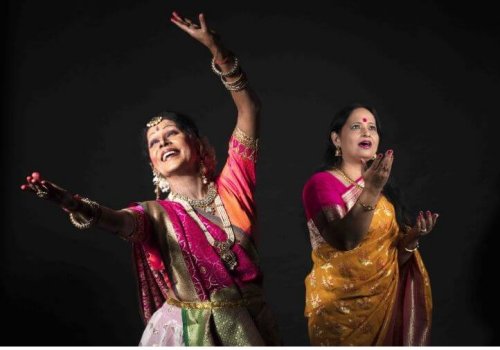
|   |

|   |
 e-mail: leelakaverivenkat@gmail.com Samyog-Viyog: Good intentions needed better treatment November 27, 2019 Kusum Awasthi Gupta's best intentions in wanting to showcase sringar rasa in a poetry/music/dance integration notwithstanding, the evening Samyog-Viyog in a collaboration featuring Asavari with Living Music Society for Arts, at Stein auditorium of Habitat in Delhi on November 13, ended in mixed feelings. One arrived to find a multi-level wooden installation on the stage, making one wonder if the dancer was going to be perched somewhere up above - till one saw the entire contraption being hammered and pulled down - with the stage having to be prepared for the music/dance interaction at the nth hour thanks to the auditorium being made available at the last minute after the previous show had finished. Artistes though seemed to take, what in this hall is a frequent enough phenomenon, in their stride. Sringar Rasa in the two contrasting situations of Samyog (union) and Viyog (separation) was supposed to be explored through music rendered by Hindustani classical vocalist Sunanda Sharma with the dance expression contributed in Kathak by Shovana Narayan, well known Kathak professional. The stage was divided into two halves - on the right a slightly raised platform accommodating Sunanda and her accompanying musicians facing the audience while on the left with open space in the middle left for the dancer, seated in a straight line facing the dancer were her accompanists. Strangely, also anchored to the centre of the stage, close to the backdrop, sitting on a chair beside a table lamp was Dr. Lavlin Thadani in saree with feet clad in footwear, as the Sutradhar. Introduced as a broadcaster associated with film and plays and a dedicated social activist, it would seem that her association with this form of dance/music interaction was limited, for how else could one explain her reading out from the copiously lengthy notes (which even for the less informed contained information not unknown to any dance audience) about the Indian aesthetic experience (rasa) common to all the classical arts - with sringar deemed the King of Rasas, explored in the joys of union as well as in the pangs of separation? And even while the dancer performed, the totally uninvolved Sutradhar seated on stage, facing the audience, was inexplicable. After a long commentary, Sunanda Sharma started the sringar journey on the happy note of Samyog with a thumri in Misrakhamaj "Tadhe rahiyo baanke Shyam, Gagariyan mai dhari aaun…kari aaun solah sringar". The nayika, full of desire asks that Krishna wait for her for she is on her way home with her filled pitchers and she will come back all dressed up in solah sringar. The dance version of the abhisarika nayika, full of desire, setting off to meet her beloved, had Shovana Narayan interpret poems of L.M. Singhvi. The poem she selected, set to raga Kedar, "Chitra likhitsa dekh rahan hoon, Mein tere angon ka vaibhav" actually portrayed the Nayak's version - looking at a picture of his beloved, full of desire with the idea of intended union. Neither did the singing by Madho Prasad (son of late Jwala Prasad who is talented but needs to evolve more) have verbal clarity nor could the dancer's interpretation fully reflect the throb of the poetry.  Shovana Narayan and Sunanda Sharma Separation in love (viyog) was expressed through a Chaiti by Sunanda Sharma "Bin piya nindiyan na aye Rama, sari sari ratiyan", woven round Radha's sleepless nights yearning for Krishna. One wondered if a lower scale would have lessened the very thin voiced singing in the higher notes, by this highly trained singer, a disciple of late Girija Devi. For portraying the pangs of separation in the dance, Shovana took two bandishes of Kunwar Shyam in raga Sugharai. "Garaj garajati goonjan aaye, main birahin Kunwar Shyam inbin" was followed by one portraying the nayika expressing her forlorn state with the nayak not having come - "Pia paas nahi kachuaas nahi." What with the overspun introductions, the entire poetry, music and dance effort seemed to hang in separate compartments not really melding into one strong statement. Till finally came the improvisatory part with music and dance spontaneously responding to each other and one experienced glimpses of what should have been right from the start. In the Kajri in Desh, "Barsana lagi badariya, Bhighi jaon mein piya bachaye laiyo" as Radha getting wet in the rain (wetness conveys a sensuality common to a lot of poetry), pleads with Krishna to let her become one with his consciousness, the element of Upaj, so central to Kathak came into play with Shovana's on the spot response to the singing bringing alive the entire concept – though here too at the start one felt that the wordless alap could have been less with a dancer also responding. And then followed the spiritual and devotional dimension of this in the khayal "Gobind gun gaavo" in Madhuvanti where singer, dancer and even drummers join in the ecstasy of oneness.  Writing on the dance scene for the last forty years, Leela Venkataraman's incisive comments on performances of all dance forms, participation in dance discussions both in India and abroad, and as a regular contributor to Hindu Friday Review, journals like Sruti and Nartanam, makes her voice respected for its balanced critiquing. She is the author of several books like Indian Classical dance: Tradition in Transition, Classical Dance in India and Indian Classical dance: The Renaissance and Beyond. Post your comments Please provide your name and email id when you use the Anonymous profile in the blog to post a comment. All appropriate comments posted with name and email id in the blog will also be featured in the site. |